Issue 18. 16 November 2009.pdf - UWA Staff - The University of ...
Issue 18. 16 November 2009.pdf - UWA Staff - The University of ...
Issue 18. 16 November 2009.pdf - UWA Staff - The University of ...
Create successful ePaper yourself
Turn your PDF publications into a flip-book with our unique Google optimized e-Paper software.
Collision<br />
avoidance<br />
anything<br />
but<br />
child’s play<br />
It might sound like many students’<br />
idea <strong>of</strong> fun to drive a BMW X5<br />
towards a balloon shaped like a<br />
full-sized Hyundai Getz.<br />
But this isn’t a prototype <strong>of</strong> a new<br />
fairground side-show attraction. It is<br />
serious science that could save<br />
thousands <strong>of</strong> lives.<br />
Director <strong>of</strong> the Centre for Intelligent<br />
Information Processing Systems and <strong>of</strong><br />
the Renewable Energy Vehicle Project<br />
(REV), Pr<strong>of</strong>essor Thomas Braunl in the<br />
School <strong>of</strong> Electrical, Electronic and<br />
Computer Engineering, explained the<br />
BMW was being fitted with an automatic<br />
collision avoidance system.<br />
“<strong>The</strong> X5 is being installed with a steerby-wire<br />
and a brake-by-wire intelligence<br />
system so that when you drive it towards<br />
another car it will stop itself before hitting<br />
the other car,” he said.<br />
“<strong>The</strong> system will be far cheaper than the<br />
radar-based systems created by major<br />
automobile manufacturers. We use<br />
image processing via a low-cost camera<br />
and it’s a system that could be retr<strong>of</strong>itted<br />
into older cars, reduced to a warning<br />
system that only alerts the driver rather<br />
than a fully automatic braking system.”<br />
Pr<strong>of</strong>essor Braunl said the avoidance<br />
system could be perfected and ready for<br />
evaluation by June next year.<br />
“For training and evaluation <strong>of</strong> the<br />
automatic emergency braking system<br />
we need a realistic looking car as a<br />
‘target’, but for safety reasons we<br />
Rhodes Scholar wants to share his passion<br />
Dustin Stuart in his physics lab<br />
Inflatable Getz and project strongmen (from left) Thomas<br />
Braunl, Frank Ophelders, Markus Kohler and Soo Siang Teoh<br />
cannot use a real car. So an inflatable<br />
car is ideal for this task,” he said.<br />
“I did some research on the internet and<br />
found a company specialising in creating<br />
strange-shaped balloons for use in<br />
advertising and promotions and sent<br />
them the drawings <strong>of</strong> the car. <strong>The</strong><br />
inflatable Getz was made in China to<br />
<strong>UWA</strong> specifications. It is made <strong>of</strong> PVC<br />
material, similar to that used in inflatable<br />
pools.”<br />
Pr<strong>of</strong>essor Braunl chose the Getz shape<br />
as the training model because the REV<br />
ECO car is a Getz converted to plug-in<br />
electric drive. Further information is<br />
available from: http://robotics.ee.uwa.<br />
edu.au/automotive.html and http://<br />
theREVproject.com/<br />
Dustin Stuart has had the best experiences <strong>of</strong> his life teaching children and<br />
teenagers about science.<br />
Some people might cite the thrill <strong>of</strong> sky-diving, the taste <strong>of</strong> a truffle or hearing a<br />
perfect violin concerto as their pinnacles, but for the 2009 Rhodes Scholar, it’s<br />
sharing his passion for science that excites him.<br />
After completing a Bachelor <strong>of</strong> Science (Advanced) in Physics and Chemistry,<br />
Dustin is finishing up his Honours project in Physics and plans to study for his<br />
DPhil in Laser Physics at Oxford <strong>University</strong> from next year.<br />
“My project will involve laser cooling atoms to a fraction <strong>of</strong> a degree above absolute<br />
zero, and using them as a quantum computer,” Dustin said.<br />
With High Distinctions and a swag <strong>of</strong> academic prizes, the 21-year-old is heading<br />
for a life in academia but along the way, he has learnt that education has the power<br />
to be life-changing.<br />
“That’s why I want to teach,” he said. “I believe education truly has the power to<br />
change people’s lives for the better. And fundamental research in physics has that<br />
potential too – to have a real effect on people’s lives.”<br />
Teaching English in India as a volunteer, running a science holiday program for<br />
primary school children and coaching teenagers competing in science Olympiads<br />
have all fuelled his passion for teaching.<br />
“I hope one day to start a science extension program to give kids the opportunity to<br />
discover science in the same way that has been so life-changing for me,” he said.<br />
<strong>The</strong> <strong>University</strong> <strong>of</strong> Western Australia <strong>UWA</strong> NEWS <strong>16</strong> <strong>November</strong> 2009 3


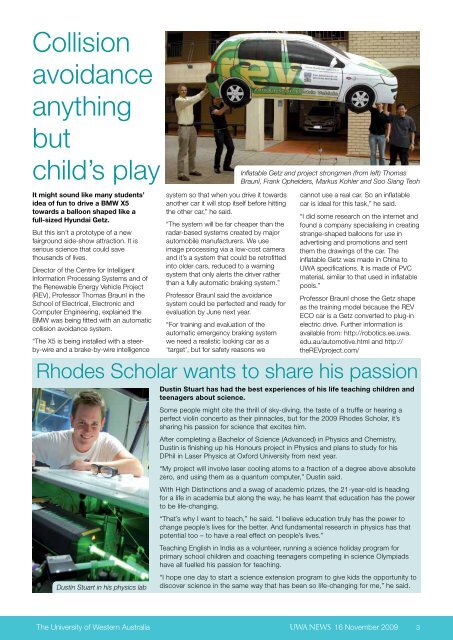
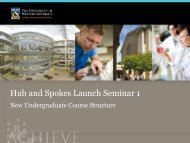

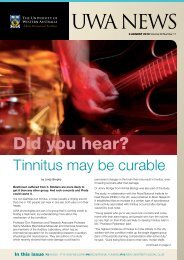





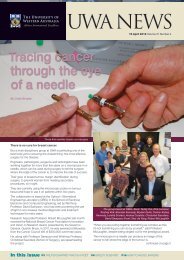
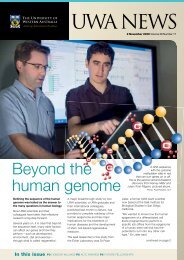
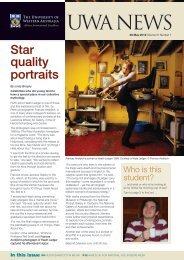

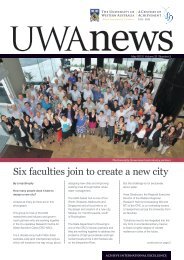
![Issue 13. 6 September 2010.pdf [PDF File, 1.7 MB] - UWA Staff - The ...](https://img.yumpu.com/26619782/1/184x260/issue-13-6-september-2010pdf-pdf-file-17-mb-uwa-staff-the-.jpg?quality=85)